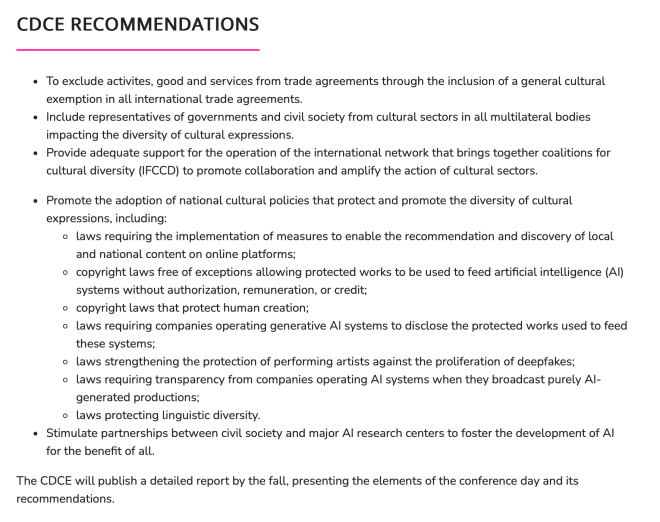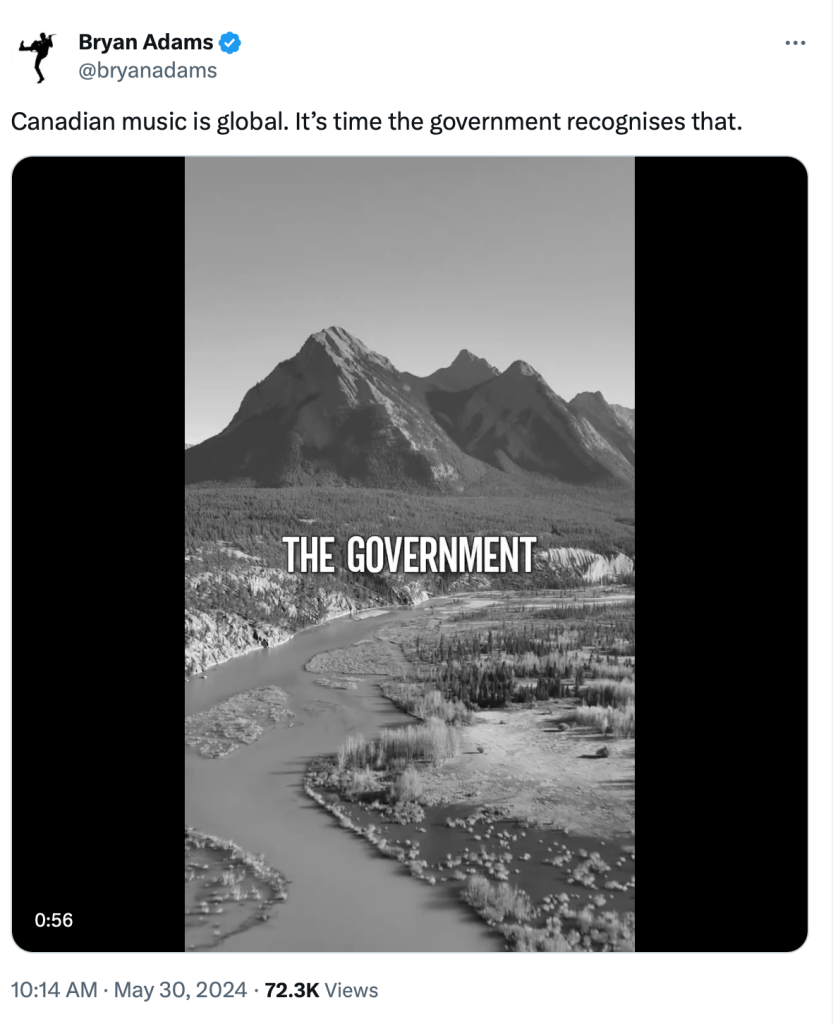
June 2, 2024
Earlier this week I posted a report on the opening day of a conference convened in Québec City by the Canadian chapter of the Coalition for the Diversity of Cultural Expression (CDCE), sponsored by the federal and provincial governments.
The Coalition is an unapologetic and energetic advocate of regulating media content to promote Canadian content domestically, but also in exchange with other like-minded countries around the world that put a high value on cultural diversity and sovereignty.
In the last few years, especially throughout the Parliamentary journey of the Online Streaming Act, the Coalition prioritized the importance of regulating platform algorithms to give greater exposure to French language music which, its fair to say, is not offered up to French speaking audiences in anywhere near the volume that radio promotes those songs.
But the Coalition also takes the long view and is the only Canadian cultural organization raising questions about the impact of AI on culture and media. The final recommendations emerging from the CDCE’s conference are captured in the photo at the beginning of this post. The recommendations not only deal with AI’s current threats to culture (for example, copyright and the interests of content creators), but focus on the public getting a look inside the Big Tech black box that holds the secret to what AI will do next.
Not so long ago the Internet took centre stage in our lives as a good thing, until we discovered that sometimes it could also be a bad thing. AI, just so, except it’s obvious right from the beginning. On that note I recommend a terrific feature piece by Navneet Alang in The Walrus.
***

Canadian rocker Bryan Adams is back, letting off steam again about CRTC regulation of Canadian content.
Adams just posted a one-minute video calling out “hey, Justin Trudeau” and weighing in on the up-for-grabs regulatory rule defining a Canadian song. That legal definition drives the key regulatory rules that increase exposure of Canadian music on radio and satellite. The Heritage Minister posted a gentle response, mindful that famous Canadian artists who publicly rebuke Canadian politicians will usually get the last word in any debate that turns nasty. The Globe & Mail‘s report is here.
Adams’ complaint is a do-over of his last, successful, political campaign against the CRTC rule that impacts how much collaboration and credit-sharing with foreign artists is allowed when Canadian artists get the benefit of the added exposure for “Canadian” songs.
In 1992 Adams was outspoken about a CRTC rule that gave Canadian credit for songs in which the music was written entirely by a Canadian, or the lyrics were written entirely by a Canadian, but not where music or lyrics were co-written by a Canadian and a foreign artist. His protest worked. The CRTC changed the rule: co-writing with non-Canadians no longer disqualifies a song.
But for Adams, it isn’t just about fixing a “bad” rule. It’s about any rule: he famously pronounced “the Canadian government should just take a step out of the music business entirely.” Another candid comment from the global superstar: “I never thought much about CanCon anyway. I always thought that it did nothing but breed mediocrity.”
Nice.
The CRTC is already thinking about watering down its “M.A.P.L.” definition of a Canadian song, which currently requires a song meet at least two out of four criteria: a Canadian performing artist (A), a Canadian music composer (M); a Canadian lyricist (L); and recorded in Canada (P). The Commission issued a ruling in December 2022 suggesting it might drop (P) and rejig the regulatory test as a two-out-of-three exercise with the remaining criteria for Canadian performers and songwriters.
The Commission then put the MA(P)L definition of a Canadian song on pause, to be resumed when the Commission re-engages the issue of “CanCon” as part of its implementation of the Online Streaming Act (although the definition of a song will be overshadowed by the debate over audio visual CanCon).
The music industry –the streamers and the labels– no doubt wish to further water down the definition of a Canadian song, part of an overall strategy of minimizing regulatory obligations to promote Canadian music on their platforms.
Here’s a bit of political irony for Adams. Justin Trudeau already weighed in on the MAPL issue, indirectly. A cabinet directive to the CRTC last November dodged the request of the Québec music industry to take a strong position on regulating the streamers’ algorithms to boost French language music.
That cabinet decision —-it’s hard to believe it was the outcome the Heritage Minister sought— did not go down easily in Québec and is the engine behind a provincial plan to step into the regulatory fight over CanCon.
***
Okay, one last thing for today.
When Hollywood showed up last November at the CRTC hearings on implementing the Online Streaming Act, I remember thinking the pitch from the Motion Picture Association was miles off base.
Instead of lecturing the Commission on how great Hollywood is for Canada —because it shoots so many American movies and TV shows here— they should have just sent Netflix CEO Ted Sarandos.
The guy is a down-to-earth charmer and very good at explaining how hard it is to be the 900-pound gorilla of the global entertainment industry. Have a listen to this New York Times podcast with Sarandos, it’s great.
***
If you would like regular notifications of future posts from MediaPolicy.ca you can follow this site by signing up under the Follow button in the bottom right corner of the home page;
or e-mail howard.law@bell.net to be added to the weekly update;
or follow @howardalaw on X.
One thought on “Catching Up on MediaPolicy – AI and Canadian culture – Et tu, Bryan Adams – How to pitch Canada on Hollywood”